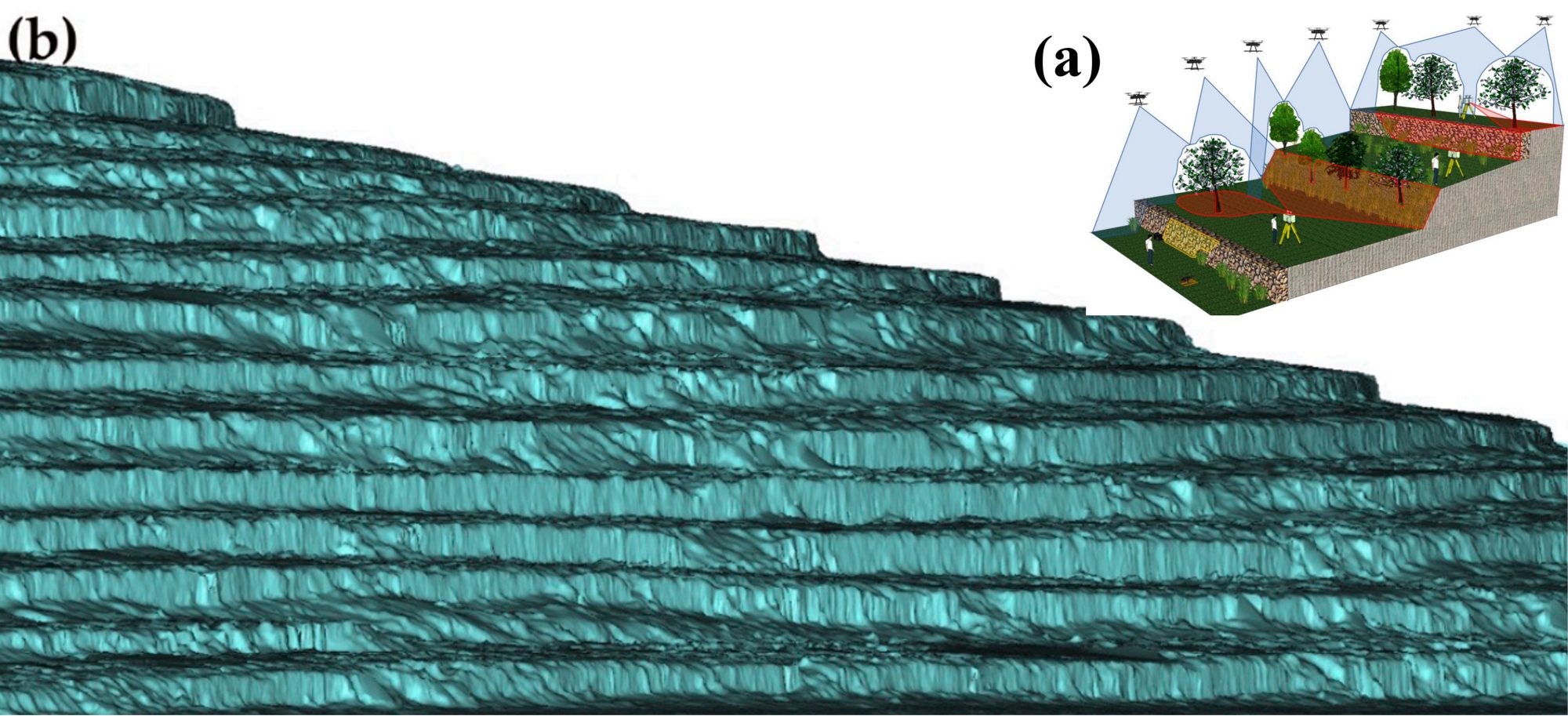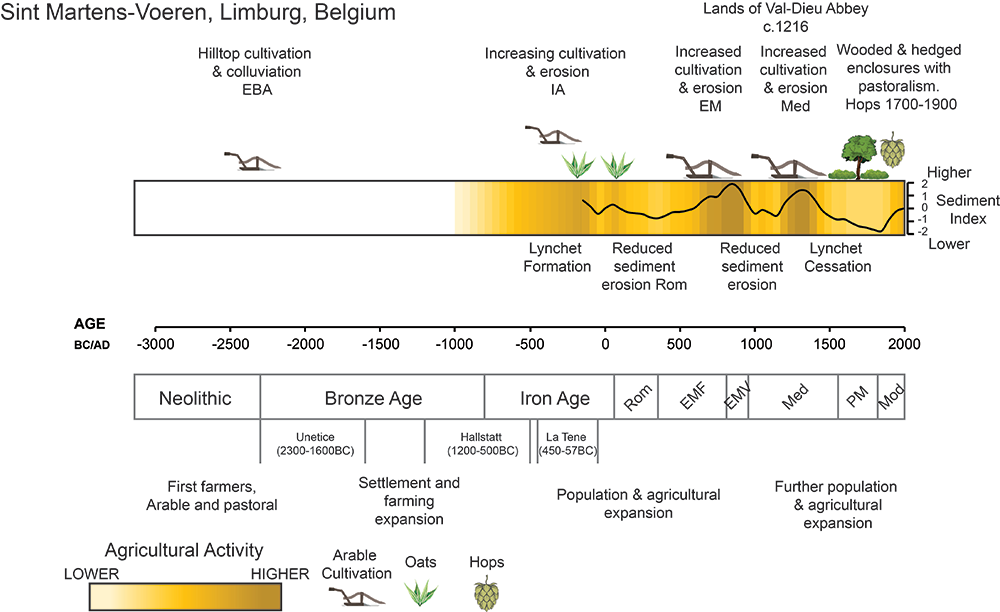Tony Brown, Dan Fallu, Sara Cucchiaro, Ben Pears, and the TerrACE Team, highlight agricultural terraces in Europe, providing geoarchaeological and botanical insights
Agricultural terraces exist in all countries in Europe but, particularly those with hilly regions where terraces can significantly increase the area of high-quality cultivatable land. Terraces, which are also common worldwide, are the largest human-made manipulations of the earth’s surface prior to the building of cities and are known to provide beneficial ecosystem services, including long-term carbon storage.
Despite this remarkably little is known about their history, and in many cases, what crops they were originally created for. They are also exceptionally resilient, mostly surviving since their first construction to the present day. However, this is changing as since the development of the caterpillar-tracked bulldozer, many have been destroyed.

Terrace Agriculture and Culture across Europe (TerrACE)
It is in this light that the European Research Council funded the project, Terrace Agriculture and Culture across Europe (TerrACE), which was undertaken from 2019-2025. TerrACE has employed cutting-edge geoarchaeological and biological methods to answer these questions – how old and what terraces were built for – using a transect of sites from Northern Norway to Crete.
These new methods have overcome many of the reasons for archaeologists and environmental scientists’ relative neglect of terraces. First among these is that the new methods of mapping and surveying terraces from both laser scanning and digital photography from autonomous airborne vehicles (UAVs or drones) have overcome the mapping problem. This was because the size of terraces was too small to be recorded universally by land survey and map making. We have combined ground-based laser scanning (TLS) with digital models created using UAVs (UAV-SfM) to create highly accurate 3D models of terrace systems, which can be used to estimate terrace soil volume and erosion potential.
Determining the age of terraces has long been a problem, so the second innovation is the dating of terraces using direct-sediment dating methods, based mainly on luminescence (e.g., optically based luminescence dating or ‘OSL’) which has improved our ability to date terraces when suitable material for radiocarbon dating (e.g., charcoal) is not present.
Further development of this, portable OSL (pOSL), allows us to measure relative ages of sediment and soil, which in turn will enable us to detect both inversion and mixing – both of which are common in terrace sequences. The result of combining OSL with radiocarbon dating is that we can show that terraces have been constructed across Europe over the last 3,500 years, with the oldest terraces being both in Crete and also northern England, whilst the peak of construction is from the Medieval period until the 19th century CE.
sedaDNA
The third and most surprising innovation has been the application of sedimentary ancient DNA (sedaDNA) to these sedimentary sequences to determine the original botanical use of the terraces. We also used the traditional methods of pollen analysis and phytolith (silica cells from plants) augmented by the analysis of seeds and charcoal in some cases.
Whilst these methods can yield valuable results in some cases, they are often just not present and/or have low taxonomic resolution. To our surprise, 11 out of 16 sites contained enough sedaDNA to determine the crops planted and grown in the past on the terraces and even the animals kept on them. Even more surprisingly, this was not limited by temperature as was hypothesized but instead by the character of the sediment and probably the clay mineralogy. This is an important finding well beyond the study of terraces and points that way to a new method of detecting environmental change from sediments all over the globe. In addition, we used a variety of methods to estimate the amount and state of soil organic carbon (SOC) contained in the terraces.
We even used the OSL dating to estimate how stable this SOC has been over the last centuries and millennia. Although there is wide variation, we have found that terraces store up to 20% more SOC than soils that have not been terraced. Along with the storage of nutrients and water, this forms the ecosystem services that terraces have provided over many centuries and that could continue to be provided if terraces are maintained or even newly constructed.
New geoarchaeological and botanical methods insights
When combined, the insights from these new geoarchaeological and botanical methods have started to solve old questions regarding why terraces were constructed and how they were used. We now have a backstory that can inform the future management of these as cultural heritage sites and also maintain or even increase environmental quality in the face of climate change. Terraces have withstood climatic changes in the past, and the opportunity to diversify the crops that they provide may be critical in many regions over the next few decades.
Further reading
- Brown, A. G., Walsh, K., Fallu, D. Cuchiarro, S. and Tarolli, P. 2021. European agricultural terraces and lynchets: From archaeological theory to heritage management. World Archaeology 52, 566-588. https://doi.org/10.1080/00438243.2021.1891963
- Brown, A.G., Fallu, D., Cucchiaro, S., Alonso, M., Albert, R.M., Walsh, K., Pears, B.R., Scaife, R., Langdon, C., Tarolli, P., Snape, L., Lang, A., Ascough, P., Zhao, P., Oost, K., Waddington, C. (2023) Early Bronze Age Agricultural Terraces in NE England: morphology, dating, and cultural implications. Antiquity 97, 348-366.
- Brown, A. G., Walsh, K., Fallu, D. Cuchiarro, S., Tarolli, P., Zhao, P., Pears, B., van Oost, K., Snape, L., Lang, A., Albert, R.M., Alsos, I., Waddington, C. 2021. Ending the Cinderella Status of Terraces and Lynchets in Europe: The Geomorphology of Agricultural Terraces and Implications for Ecosystem Services and Climate Adaptation, Geomorphology 379, 107579. https://doi.org/10.1016/j.geomorph.2020.107579
- Cucchiaro, S., Paliaga, G., Fallu, D.J., Pears, B.R., Walsh, K., Zhao, P., Van Oost, K., Snape, L., Lang, A., Brown, A.G., Tarolli, P. 2021. Volume estimation of soil stored in agricultural terrace systems: a geomorphometric approach. Catena 207, 105687, https://doi.org/10.1016/j.catena.2021.105687
- Pears, B., Lang, A., Fallu, D., Roberts, M., Jacques, D., Snape, L., Mauz, B., Bahl, C., Van Oost, K., Zhao, P., Tarolli, P., Cucchiaro, S., Walsh, K., Brown, A. G. 2024. Lynchets, loess and agricultural resilience: construction, function and chronology of lynchets-type terraces on chalk landscapes in the UK and Belgium. European Journal of Archaeology doi:https://doi.org/10.1017/eaa.2024.6
- Zhao, P., Fallu, D.J., Pears, B.R., Allonsius, C., Lembrechts, J., Van de Vondel, S., Meysman, F., van Wesemael, B., Six, J., Brown, A.G., Van Oost, K. 2023. Quantifying the soil properties relevant to SOC biogeochemical cycles by combining infrared spectroscopy with compositional data analysis. Soil & Tillage Research 231, 1055718 https://doi.org/10.1016/j.still.2023.105718
- Zhao, P., Doetter, S., Wang, Z., Hoyt, A.M., Wang, E., Yu, H., Quijano, L., Fallu, D. F., Brown, A.G., Six, J., Van Oost. K. 2022. Factors controlling SOC stability in colluvial soils under contrasting climate and soil weathering conditions. European Journal of Soil Science 73, 313311.
- Zhao, P., Fallu, D., Cucchiaro, S., Tarolli, P., Waddington, C., Cockcroft, D., Snape, L., Lang, A., Doetterl, S., Brown, A. G., Van Oost, K. 2021. SOC stabilization mechanisms and temperature sensitivity in old terraced soils. Biogeosciences18, 6301-6312.

This work is licensed under Creative Commons Attribution-NonCommercial-NoDerivatives 4.0 International.


